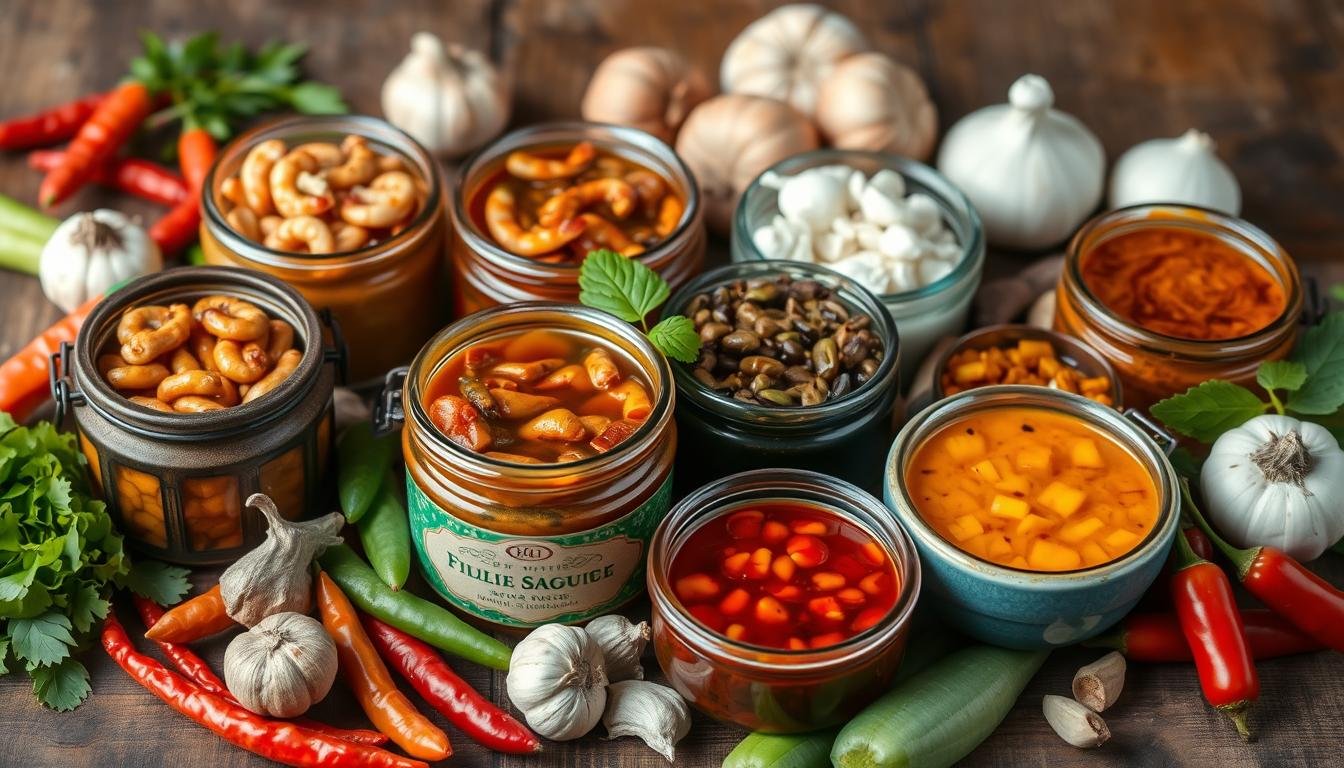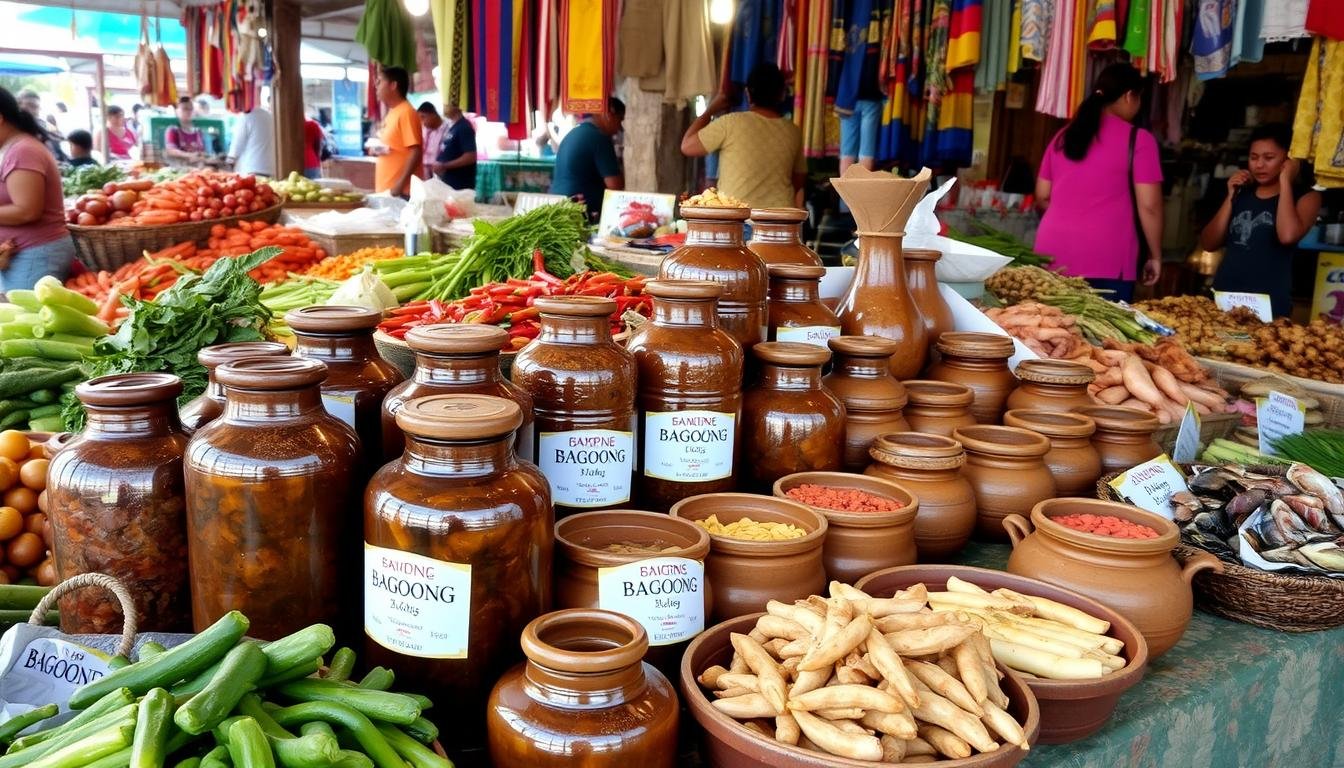Ever wondered about the bold, umami-rich flavors in authentic Filipino dishes? The secret is bagoong, a fermented seafood paste key to Pangasinan’s food culture. But what is bagoong, and how can it make your cooking better? Get ready for a flavorful adventure as we dive into bagoong’s types, flavors, and uses.
Key Takeaways
- Bagoong is a fermented seafood paste that is an essential ingredient in Filipino cuisine, particularly in the Pangasinan region.
- There are various types of bagoong, each with its own unique characteristics and uses, such as bagoong alamang, bagoong isda, and bagoong monamon.
- Bagoong is prized for its salty, umami-rich, and distinctly fishy flavors, which can enhance a wide range of dishes.
- Bagoong can be used as a seasoning, a dipping sauce, or an integral component in traditional Pangasinan dishes like pakbet and sinigang.
- Bagoong is not only a culinary treasure but also a reflection of Pangasinan’s rich cultural heritage and artisanal food production practices.
Types of Bagoong in Pangasinan
Pangasinan, a province in the Philippines, is famous for its many types of bagoong. This fermented seafood condiment adds depth and umami flavor to local dishes. From bagoong alamang made with small shrimp to bagoong isda from various fish, the region offers unique bagoong types. Each has its own character and uses in cooking.
Bagoong Alamang: Small Shrimp Bagoong
Bagoong alamang is a favorite in Pangasinan, made from small shrimp or krill. It’s a briny, pungent condiment used in many local dishes. It’s a key flavor in pinakbet (vegetable stew) and sinigang (sour soup).
Bagoong Isda: Fish Bagoong
Bagoong isda is another common type in Pangasinan, made from fish like herring, anchovies, or scad. The fermentation makes a savory, umami-rich condiment. It’s great for enhancing flavors in adobo (braised meat) and ensaladang talong (eggplant salad).
Bagoong Monamon: Bagoong with Anchovies and Scad
Bagoong monamon, or bagoong monamon-dilis, is a special mix of fermented anchovies and scad. It’s a key ingredient in Pangasinan and Northern Ilocano cuisine. It’s often used instead of salt, soy sauce, or monosodium glutamate.
Beyond these well-known types, Pangasinan also has unique bagoong varieties like bagoong terong, ginamos, tinabal, bagoong padas, and bagoong sisi. Each has its own ingredients and characteristics. The variety of bagoong in this region shows the culinary heritage and innovation of the local community.
Flavors and Characteristics
Bagoong, a fermented seafood condiment from Pangasinan, has a unique taste. Its main flavor is salty. This comes from the high salt used in making it.
Bagoong also has a rich, umami-rich taste. This comes from the fermentation process. It breaks down proteins, releasing amino acids that add to its flavor.
The most unique thing about bagoong is its fishy smell and taste. The fermented seafood gives it a strong, pungent flavor. This makes bagoong loved by some and hated by others.
| Bagoong Flavor | Description |
|---|---|
| Salty | The primary flavor of bagoong, a result of the salting and fermentation process. |
| Umami | A savory and complex flavor profile, derived from the breakdown of proteins during fermentation. |
| Fishy | A distinctive aroma and taste that comes from the fermented seafood ingredients used to make bagoong. |

Whether you love bagoong or are trying it for the first time, knowing its flavors is important. It helps you enjoy it more in your cooking.
How to Use Bagoong
Bagoong is a unique Filipino ingredient made from fermented shrimp or fish paste. It can make many dishes better. Whether you’re making a classic Filipino dish or adding flavor to a salad, bagoong brings a savory umami taste that’s sure to please.
Cooking with Bagoong
Bagoong is key in many Filipino dishes. It’s found in sour sinigang, vegetable-rich pinakbet, and flavorful adobo. Its salty and umami flavors mix well with other ingredients, making the dish richer and more complex.
Bagoong as a Condiment
Bagoong is also great as a condiment. Try it with kare-kare or laing for dipping. Or mix it with honey for a sweet-and-salty sauce. You can even add it to salads for a surprising twist.
Bagoong is a must-have in Filipino cooking. It adds a salty and umami flavor to many dishes.
Cultural Significance and Traditions
Bagoong, a fermented seafood condiment, is deeply rooted in Pangasinan’s culture. It’s a key part of their local cuisine and traditions. This umami-rich seasoning is a big part of their celebrations and festivals, showing its importance in Pangasinan’s food identity.
Bagoong’s Role in Local Celebrations and Festivals
Pangasinan’s festivals, like the Bangus Festival and Pistay Dayat, are known for their rich culture. Bagoong is a big part of these celebrations. It’s often used with bangus (milkfish), adding a unique savory flavor to their dishes.
Bagoong’s role in these festivals shows its strong connection to Pangasinan’s traditions and community.
Stories and Legends Associated with Bagoong
Beyond its taste, bagoong has stories and legends that have been passed down for generations. These tales often talk about how it’s made and its unique flavors. They highlight the artisanal production process that makes bagoong special.
These legends add to Pangasinan’s cultural richness, keeping their food heritage alive. They celebrate the skill and tradition behind this fermented seafood delicacy.
Bagoong is more than just a condiment in Pangasinan. It symbolizes the province’s culinary identity. It connects people to their traditions and celebrates the diversity of their food heritage.

Conclusion
Bagoong is a key part of Filipino cuisine, especially in Pangasinan. It comes in many types, like bagoong alamang and bagoong isda. Each type adds unique flavors to traditional dishes and celebrations.
Trying bagoong for the first time is exciting. It’s packed with umami that makes Filipino food even better. Adding it to your cooking will bring out new flavors.
Bagoong’s importance in Pangasinan shows its cultural value. Exploring its flavors connects you to the Philippines’ rich food culture. It’s a journey into the heart of Filipino cuisine.
FAQ
What is bagoong?
What are the different types of bagoong in Pangasinan?
What are the flavors and characteristics of bagoong?
How can you use bagoong in cooking?
What is the cultural significance of bagoong in Pangasinan?
Source Links
- Types of Bagoong: Bagoong Alamang, Bagoong Isda, and More
- Traditional Food Tripping Pangasinan
- Patis and Bagoong in Pangasinan
- Bagoong
- Bagoong monamon
- Fermented Fish Products in the Philippines – Applications of Biotechnology to Fermented Foods
- Top 10 Pangasinense Dishes and Delicacies You Should Try
- ‘Bagoong’ drives backyard businesses in Pangasinan
- How to Make Ginisang Bagoong
- What is Bagoong Alamang?
- How to Make Bagoong by Sarahlynn Pablo
- Exploring the Culture of Pangasinan: Traditions & Arts
- About Pangasinan | The Official Website of the Province of Pangasinan
- Eight Attributes of Culture: Looking into the Culture of Pangansinenses
- Microsoft Word – Vol. II(2
